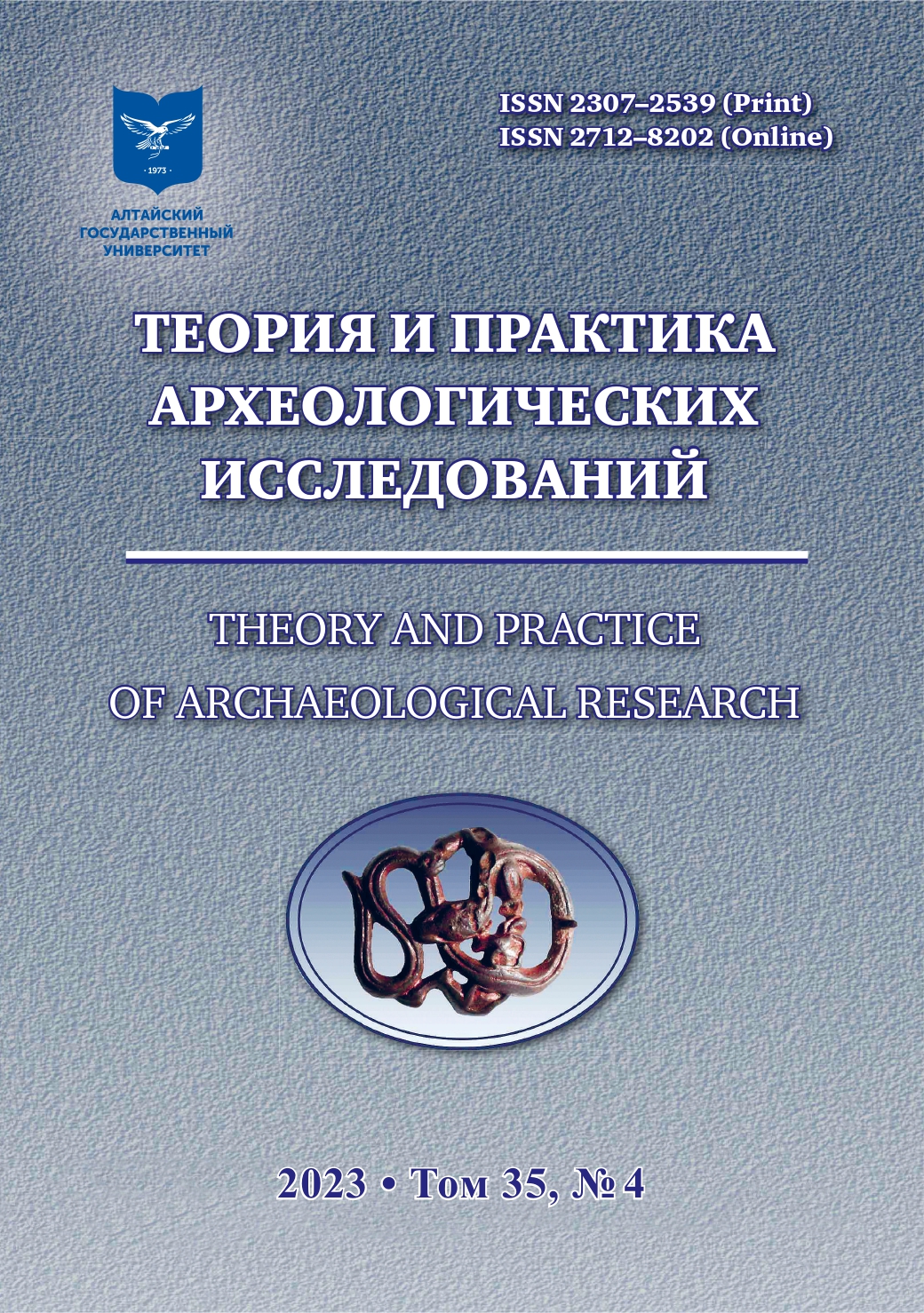THE ROLE OF THE OSTROV NYASHA-I SITE IN THE CONSTRUCTION OF THE CULTURAL AND CHRONOLOGICAL SCHEME OF THE LOWER TOM REGION
Abstract
The article presents for the first time the results of the study of the site Ostrov Nyasha-I, located in the north of the Lower Tom region, discovered in 2021. The stratigraphic situation at the site is analyzed, and a conclusion is made about its single-layer nature. The preliminary results of the cultural and chronological attribution of the ceramic complex of the monument are presented, which allowed to reveal the simultaneous occurrence of the Novokuskovsky and Igrekovsky types of ceramics. Two AMS-dates obtained from charcoal from the culture-containing layer and two AMS-dates obtained from carbon deposits on ceramics are presented. According to the authors of the article, the freshwater reservoir effect leads to older the last dates. This fact, combined with the presence of materials from two cultural traditions in a single-layer site, allowed raising questions about the possible incorrectness of most of the dates available for Neolithic-Eneolithic sites of the Tomsk-Chulym Ob region, and the need to revise the cultural and chronological scheme of the designated region. Based on absolute dates, the site Ostrov Nyasha-I is dated to the end of the first — second quarter of the 5 millennium B.C. and attributed by the authors to the Late Neolithic period. The special role of the monument in the construction of the cultural and chronological scheme of the Lower Tom region and the need for its further research were noted.
Downloads
Metrics
No metrics found.
References
Zaitseva G.I., Skakovskii E.D., Sementsov A.A., Lebedeva L.M., Burova N.D., Rishko S.A. Chemical Composition of Carbon-contained Components in Neolithic Pottery. In: Radiocarbon Neolithic Chronology of Eastern Europe in the 7th –3rd Millennium BC. Smolensk : Svitok, 2016. Pp. 32–37. (In Russ.)
Zakh V.A. On the Cultural Affiliation of the Neolithic Sites of the Salair and Ob Regions. In: Chronology and Cultural Affiliation of Sites of the Stone and Bronze Ages of Southern Siberia. Barnaul : Izd-vo Alt. un-ta, 1988. Pp. 35–37. (In Russ.)
Zakh V.A. The Neolithic and Early Metal Ages of the Forest-Steppe Salair and Ob Regions. Tyumen : Izd-vo IPOS SO RAN, 2003. 168 p. (In Russ.)
Kiryushin Yu.F. Periodization of Neolithic and Bronze Age Cultures of the Upper and Middle Ob Regions. In: Chronology and Cultural Affiliation of Sites of the Stone and Bronze Ages of Southern Siberia. Barnaul : Izd-vo Alt. un-ta, 1988. Pp. 59–63. (In Russ.)
Kiryushin Yu.F. Problems of the Chronology of Chalcolithic and Bronze Age Sites in Southern Siberia. In: Problems of Chronology and Periodization of Archaeological Sites of Southern Siberia. Barnaul : Izd-vo Alt. un-ta, 1991. Pp. 43–47. (In Russ.)
Kiryushin Yu.F. Eneolithic and Early Bronze Age of the South of Western Siberia. Barnaul: Izd-vo Alt. un-ta, 2002. 294 p. (In Russ.)
Kiryushin Yu.F. Eneolithic and Bronze Age of the Southern Taiga Zone of Western Siberia. Barnaul : Izd-vo Alt. un-ta, 2004. 295 p. (In Russ.)
Komarova M.N. Tomsk Burial Ground, a Monument to the History of the Ancient Tribes of the Forest Belt of Western Siberia.. Moscow : Izd-vo AN SSSR, 1952. Pp. 7–50. (MAI. No. 24). (In Russ.)
Kondrashov A.N. Research Materials from the Pyl-Karamo-1 Soil Burial Ground and the Ust-Poros Settlement in the North of the Tomsk Region. In: Materials and Research on the History of North-Western Siberia. Yekaterinburg : Izd-vo Ural. gos. un-ta, 2002. Pp. 63–69. (In Russ.)
Kosarev M.F. Ancient Cultures of the Tomsk-Narym Ob Region. Moscow : Nauka, 1974. 167 p. (In Russ.)
Kosarev M.F. Bronze Age of Western Siberia. Moscow : Nauka, 1981. 282 p. (In Russ.)
Kulkova M.A. Radiocarbon Dating of Ancient Pottery. Samarskij nauchnyj vestnik = Samara Journal of Science. 2014;3(3):115–122. (In Russ.)
Kulkova M.A., Mazurkevich A.N., Nesterov E.M., Sinai M.Y. The Analysis of Stable Isotopes and Radiocarbon Dating of Artefacts of the Neolithic Site Serteya-II (Dvina-Lovat’ interfl uve). In: Archaeology of Lake Settlementsth 4th — 2nd Mill. BC: Chronology of Cultures, Environment and Palaeoclimatic Rhythms. Saint-Petersburg : Periferiya, 2014. Pp. 33–35. (In Russ.)
Marochkin A.G. Th e Cultural and Historical Concept of the Neolithic and Early Metal of the Upper Ob Basin in the National Historiography of the 1970s — the Beginnings of the 2010s. Vestnik Tomskogo gosudarstvennogo pedagogicheskogo universiteta = Tomsk State Pedagogical University Bulletin. 2013а;7(135):84–90. (In Russ.)
Marochkin A.G. Neolithic and Early Metal Upper Ob: Origins of Scientifi c Understanding. Vestnik Tomskogo gosudarstvennogo pedagogicheskogo universiteta = Tomsk State Pedagogical University Bulletin. 2013b;7(135):96–100. (In Russ.)
Marochkin A.G. Funeral Practice of the Population of the Upper Ob Region during the Neolithic and Eneolithic Periods (history of study, structural analysis and typology, problems of cultural and chronological interpretation): Abstract Dis. ... Cand. of Historical Sciences. Kemerovo, 2014. 33 p. (In Russ.)
Marochkin A.G., Sizev A.S., Yurakova A.Yu., Gavrilov D.A., Khairulina K.D. Stratigraphy of the Pisanaya-4 Settlement near the Tomskaya Pisanitsa Petroglyphic Site. Problemy arheologii, etnografi i, antropologii Sibiri i sopredel’nyh territorij = Problems of Archaeology, Ethnography, Anthropology of Siberia and Neighboring Territories. 2021;27:511–519. (In Russ.)
Marochkin A.G., Yurakova A.Yu. Neolithic-Eneolothic Findings from Dolgaya-1 Site (south of Lower Tom’ region). Vestnik Novosibirskogo gosudarstvennogo universiteta. Seriya: Istoriya, Filologiya = Vestnik NSU. Series: History and Philology. 2014;13(3):189–201. (In Russ.)
Matyushchenko V.I. The Ancient History of the Population of the Forest and Forest-Steppe Ob region (Neolithic and Bronze Age). Part 1. Neolithic Time in the Forest and Forest-steppe Ob Region (Verhneobskaya Neolithic culture). In: From the History of Siberia. Issue 9. Tomsk: Izd-vo Tom. un-ta, 1973. 149 p. (In Russ.)
Meadows J. Food-crust Ingredients and Their Implications for the Chronology of Neolithic Pottery. In: Archaeology of Lake Settlements of the 4th — 2nd Mill. BC: Chronology of Cultures, Environment and Palaeoclimatic rhythms. Saint-Petersburg : Periferiya, 2014. Pp. 42–44. (In Russ.)
Molodin V.I. Neolithic and Bronze Ages of the Forest-Steppe Ob-Irtysh Region. Novosibirsk: Nauka, 1977. 174 p. (In Russ.).
Molodin V.I., Zakh V.A. Geomorphological Location of Neolithic and Bronze Age Sites in the Basins of the Ob, Inya, Om Rivers and Th eir Tributaries. In: Features of the Natural-Geographical Environment and Historical Processes in Western Siberia. Tomsk : Izd-vo Tom. unta, 1979. Pp. 51–53. (In Russ.)
Molodin V.I., Mylnikova L.N., Nesterova M.S., Kobeleva L.S., Nenakhov D.A. Baraba Culture of Early Neolithic Period. Vestnik Novosibirskogo gosudarstvennogo universiteta. Seriya: Istoriya, Filologiya = Vestnik NSU. Series: History and Philology. 2020;19(7):69–93. (In Russ.)
Mosin V.S., Bobrov V.V., Marochkin A.G. New Absolute Dates for the Trans-Uralian and Western Siberian Neolithic. Arheologiya, etnografi ya i antropologiya Evrazii = Archaeology, Ethnology and Anthropology of Eurasia. 2017;45(4):65–73. (In Russ.)
Rudkovsky I.V. The Pottery from the Cherdashny Log Settlement. In: Archaeology and Ethnography of the Ob Region: Materials and Research. Issue 1. Tomsk : Izd-vo Tom. gos. ped. un-ta, 2007. Pp. 92–102. (In Russ.)
Rudkovsky S.I. Explanatory Note to the Collection from Nyasha Island (№6050) in the Tomsk District of the Tomsk Region in 1998. Seversk, 2009. 3 p. In: Archive of the Seversk Museum. (In Russ.)
Sinitsina G.V. Igrekovo-I — a Neolithic Site in the Middle Ob Region. In: Paleolithic and Neolithic. Leningrad : Nauka, 1986. Pp. 100–108. (In Russ.)
Sinitsina G.V. Neolithic Site Igrekovo II in the Middle Ob Region. Kratkie soobshcheniya Instituta arheologii = Brief Communications of the Institute of Archaeology. 1991;203:78–84. (In Russ.)
Sinitsina G.V. On the Chronology of the Igrekovo 1 and Igrekovo 2 Sites in the Middle Ob Region. In: Time and Culture in Archaeological and Ethnographical Research of Ancient and Modern Societies of Western Siberia and Adjacent Territories: the Problems of Interpretation and Reconstruction. Tomsk : Agraf-Press, 2008. Pp. 193–197. (In Russ.)
Shirin Yu.V. Materials of Archaeological Exploration on the Tom River. In: From Kuznetsk Antiquity. Issue 6. Novokuznetsk : Kuzneckaya krepost’, 2015. Pp. 4–75. (In Russ.)
Fischer A., Heinemeier J. Freshwater Reservoir Effect in 14C Dates of Food Residue on Pottery. Radiocarbon. 2003;45(3):449–466.
Copyright (c) 2023 Ю.К. Квасница, Д.А. Бычков, А.А. Идимешев

This work is licensed under a Creative Commons Attribution 4.0 International License.
Theory and Practice of Archaeological Research is a golden publisher, as we allow self-archiving, but most importantly we are fully transparent about your rights.
Authors may present and discuss their findings ahead of publication: at biological or scientific conferences, on preprint servers, in public databases, and in blogs, wikis, tweets, and other informal communication channels.
Theory and Practice of Archaeological Research allows authors to deposit manuscripts (currently under review or those for intended submission to ABS) in non-commercial, pre-print servers such as ArXiv.
Authors who publish with this journal agree to the following terms:
- Authors retain copyright and grant the journal right of first publication with the work simultaneously licensed under a Creative Commons Attribution License (CC BY 4.0) that allows others to share the work with an acknowledgement of the work's authorship and initial publication in this journal.
- Authors are able to enter into separate, additional contractual arrangements for the non-exclusive distribution of the journal's published version of the work (e.g., post it to an institutional repository or publish it in a book), with an acknowledgement of its initial publication in this journal.
- Authors are permitted and encouraged to post their work online (e.g., in institutional repositories or on their website) prior to and during the submission process, as it can lead to productive exchanges, as well as earlier and greater citation of published work (See The Effect of Open Access).







2.jpg)





